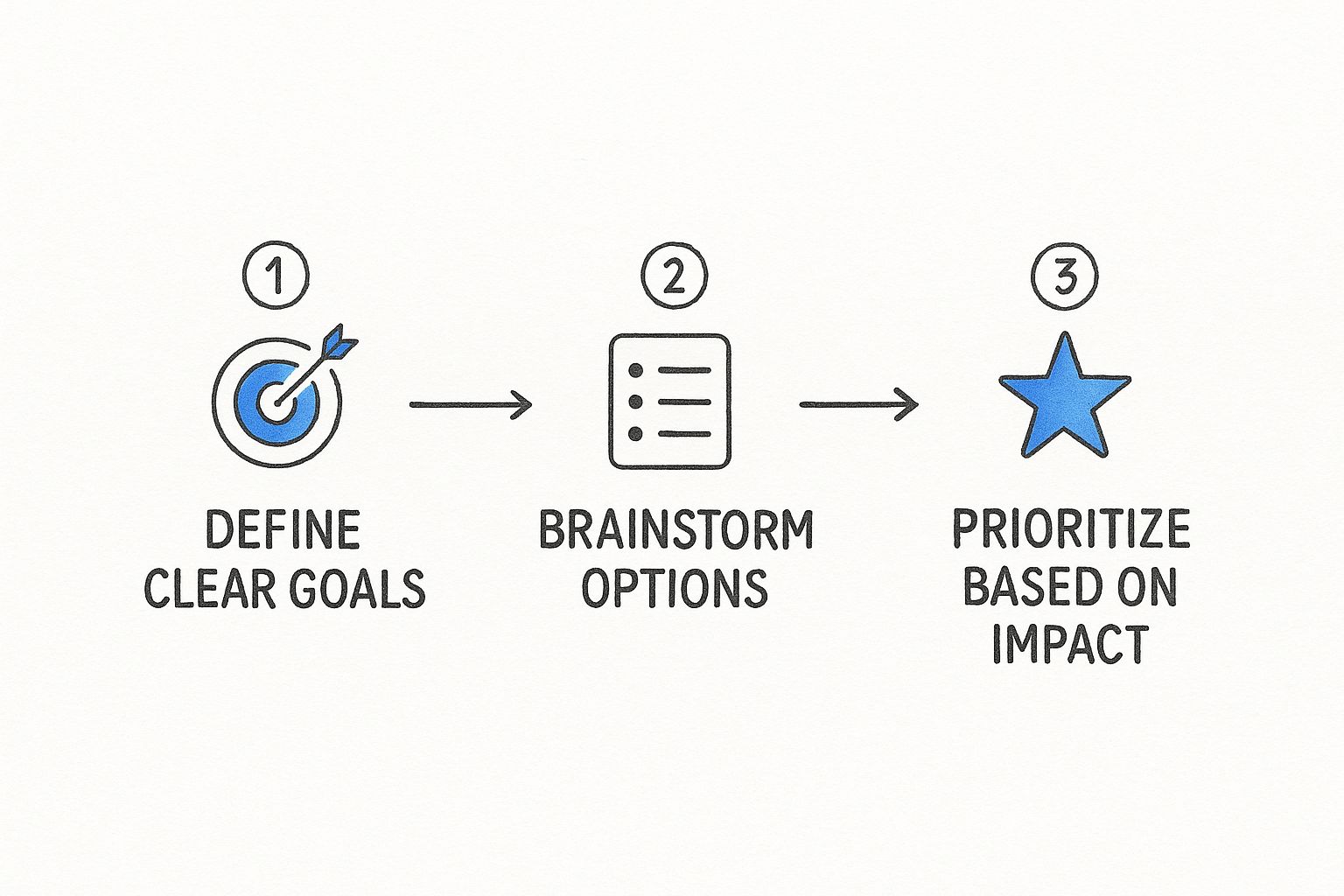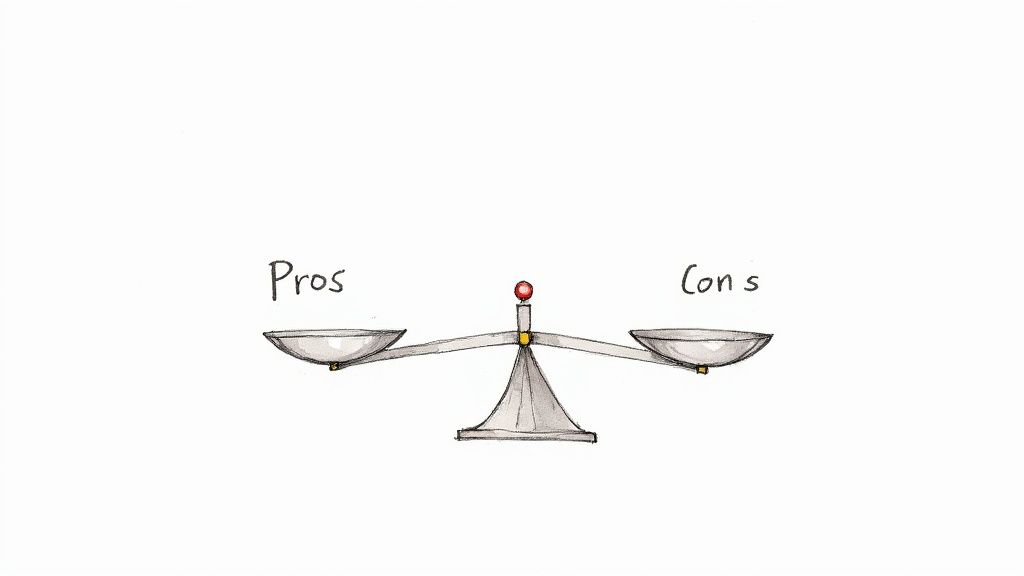Business Innovation Models: Drive Growth & Stay Competitive
Oct 7, 2025 in Guide: Explainer
Explore top business innovation models with real examples. Learn to select and apply frameworks that boost growth and keep you ahead.
Not a member? Sign up now
NILG.AI on Oct 4, 2025
If you really want to get better at making decisions, you have to move past relying on pure instinct. It’s about blending your hard-won experience with proven mental frameworks, learning to spot your own biases, and actually using data to guide your choices.
This isn’t about ignoring your gut—it’s about backing it up with a systematic process to get better results, time and time again.
We’ve all heard those stories about a leader who made a brilliant, game-changing call based on nothing more than a gut feeling. It sounds amazing, right? Decisive. Heroic, even.
But in the real world of business, where the stakes are high, leaning only on intuition is like trying to sail through a hurricane without a compass. Your experience is incredibly valuable, no doubt, but it was forged in past situations that might have zero in common with what you’re facing today. That’s where structured thinking gives you a serious edge.
When you rely on instinct alone, you’re basically inviting common mental traps to mess with your judgment. Our brains love taking shortcuts, but those shortcuts often lead to bad conclusions when the problem is complex. A decision that feels right might just be your confirmation bias patting you on the back for sticking to what you already believe.
To see this in action, let’s quickly compare the two approaches.
| Aspect | Intuitive Decision Making | Structured Decision Making |
|---|---|---|
| Basis | Gut feelings, experience, instinct | Data, frameworks, logical analysis |
| Speed | Fast, almost instantaneous | Slower, more deliberate |
| Best For | Quick, low-stakes choices | Complex, high-impact decisions |
| Risks | High susceptibility to cognitive biases | Can lead to “analysis paralysis” if not managed |
| Outcome | Inconsistent, hit-or-miss results | More consistent, defensible outcomes |
A structured approach doesn’t guarantee a perfect outcome, but it dramatically improves your odds and makes your reasoning clear to everyone involved.
Here’s a fascinating disconnect: most of us think we’re great at making decisions, but our methods say otherwise.
A 2025 global study from the Global Association of Applied Behavioural Scientists (GAABS) really nailed this. They found that while a whopping 91% of experienced professionals rated their decision-making skills as above average, almost half (45%) admitted they didn’t have any structured habits for making important calls at work. You can dig into some of the specific challenges people face in the full study on Statista.com.
This gap tells us something crucial: confidence isn’t the same as competence. The real key is building a repeatable system that forces you to look at options objectively and keeps emotion and hidden biases out of the driver’s seat.
“Getting to the ‘right answer’ without anybody supporting it or having to execute it is just a recipe for failure. The quality of the decision is only one part of the equation.”
This quote gets to the heart of it. The process you use is just as important as the final choice. A solid, structured approach makes sure your logic holds up, your assumptions have been pressure-tested, and your team is actually on board with where you’re headed.
It shifts you from being a reactive guesser to a proactive strategist. You’re no longer just crossing your fingers for a good outcome; you’re actively engineering it. This is a lot like reverse engineering, where you start with the result you want and work backward to figure out how to get there. It’s a powerful technique we cover in our guide on reverse engineering with machine learning.
By bringing some simple frameworks into your routine, you create a buffer against impulsive choices and lay the groundwork for making smarter, more defensible decisions every single time.
When you’re staring down a tough decision, just thinking harder rarely works. We’ve all been there. Instead of going with your gut or getting stuck in analysis paralysis, a good framework can be a game-changer. It gives you a mental scaffold to organize your thoughts and look at the problem from every angle.
This isn’t about replacing your intuition; it’s about backing it up with a solid, structured process. Think of it as a checklist for your brain. It forces you to hit pause, consider alternatives you might have glossed over, and actively challenge your own assumptions before you commit.

As you can see, a solid process always starts with clear goals, moves to exploring all your options, and wraps up by focusing on what will actually move the needle. Let’s dig into two powerful frameworks that bring this idea to life.
I’m a big fan of the WRAP framework, developed by authors Chip and Dan Heath. It’s brilliant because it directly attacks the narrow framing that trips up so many of our decisions. WRAP is an acronym for four steps that push you past your initial gut reaction.
Working through these four steps systematically can dramatically upgrade the quality of your decisions.
A huge benefit of using a framework is that it forces you to build healthy conflict into the process. This isn’t about picking fights. It’s about encouraging your team to poke holes in assumptions and bring hidden risks to the surface—things a consensus-at-all-costs approach would completely miss.
Another fantastic tool is the OODA Loop. It comes from military strategist John Boyd, who developed it for fighter pilots. Its real power is in its speed and adaptability, which makes it perfect for the fast-paced business world where you have to react quickly without being reckless.
The loop breaks the decision cycle into four distinct stages:
This isn’t a one-and-done process. It’s a continuous cycle that lets you learn and adapt in real-time. By consciously moving through each stage, you build a powerful habit of refining your choices on the fly—a skill that’s absolutely essential for any modern leader.
It’s always tempting to go with your gut on a big call. We’ve all been there. But relying on intuition alone is a risky game. If you really want to level up your decision-making, you have to start grounding those instincts in cold, hard evidence.
This isn’t about suddenly becoming a data scientist. It’s about getting curious, asking smarter questions, and knowing where to find the answers in the numbers. The whole point is to let objective facts steer you away from personal bias, leading to choices that are not only easier to defend but also far more likely to pay off.

The first hurdle is figuring out which data actually matters. Too many leaders get hung up on vanity metrics—those shiny numbers that look great in a report but don’t mean a thing for the bottom line. Think website traffic that never converts or a flood of social media likes that don’t translate into sales.
What you need are actionable metrics. These are the numbers that tie directly to your business goals and give you a clear signal on what to do next.
Let’s look at a real-world example:
Suddenly, the choice is obvious. You allocate the budget to the channel that actually gives you the best return—a decision backed by solid performance data, not just fuzzy engagement.
The real magic happens when you start blending different kinds of data. Don’t just look at the ‘what’ from your spreadsheets; you have to dig into the ‘why’ from your customers. The numbers tell you a story is unfolding, but talking to people gives you the plot.
Data isn’t just about numbers sitting in a database. Often, the most valuable insights come directly from people. This qualitative feedback provides the context and nuance that a spreadsheet completely misses.
Say you’re a product manager trying to figure out which feature to build next. Your analytics might show that 75% of users are dropping off at a particular screen in your app. Okay, so you know where the problem is, but you have no idea why.
This is where you need to get qualitative. You could:
By putting the quantitative data (the drop-off rate) together with the qualitative feedback (the reasons for it), you can make a much smarter decision about what to fix. You end up solving a real problem for real people, which is the core of any good data-driven decision-making process.
Making this shift isn’t just a personal upgrade; it can transform your entire organization. The trend is undeniable—data-driven practices are becoming the gold standard for top-performing companies. It’s estimated that over 65% of major companies globally will be using data-driven approaches by 2025. What’s more, businesses that lean into their data are five times more likely to make decisions faster and see a 6% boost in productivity.
You don’t need a fancy, expensive business intelligence platform to get started. Just begin with small, simple steps.
Create a shared dashboard with a handful of key metrics that the whole team can see. In meetings, start gently pushing back on “I think…” statements. Encourage your team to frame their ideas with, “The data from our last campaign suggests…”
This small change in language starts building a culture where evidence trumps opinion. It turns decision-making from a guessing game into a strategic exercise, making your entire team sharper and more effective.
Your brain is a shortcut machine. It has to be, otherwise you’d get stuck deciding what socks to wear. To get through the thousands of micro-decisions we make every day, our minds rely on mental cheat sheets, often called heuristics. They work great for small stuff.
But for high-stakes business decisions? Those same shortcuts can lead you straight off a cliff.
These mental glitches are what we call cognitive biases. They’re like bugs in your thinking software that quietly push you toward a bad call, even when you’re trying your best to be objective. A huge part of getting better at making decisions is simply learning to spot these biases in the wild—especially in your own head.

Let’s break down a few of the biggest culprits.
This one is sneaky. Confirmation bias is our natural habit of seeking out and overvaluing information that proves what we already believe. It’s that little voice that says, “See? I knew it!” It feels good to be right, but it’s a massive blind spot in business.
Say you’re dead-set on launching a new feature. If you’re in the grip of confirmation bias, you’ll start to:
You essentially build an echo chamber around your idea, making it impossible to see the flaws.
Bias-Check Question: “What evidence would I need to see to know I’m wrong?” Asking this forces you to actively hunt for the very information you’re inclined to ignore.
Ever notice how the first number thrown out in a negotiation seems to stick? That’s the anchoring effect. Our brains have a weird tendency to latch onto the first piece of information we get and use it as a mental “anchor” for everything that follows.
This happens constantly in business. During budget talks, if the first number someone mentions for a new project is $50,000, that figure sets the tone. A revised proposal for $40,000 suddenly feels like a great deal, while a more realistic estimate of $25,000 might seem shockingly low. The first number skewed your whole perspective.
This isn’t just about money, either. It messes with hiring, deadlines, and performance reviews. A great way to fight this in hiring, for instance, is using a structured interview rating sheet to remove bias. It forces everyone to evaluate candidates on the same objective criteria, preventing a strong (or weak) first impression from anchoring the entire decision.
Bias-Check Question: “If I had heard a totally different number or piece of information first, how would my thinking change?” This is a great way to mentally reset your anchor.
Ah, the “throwing good money after bad” trap. The sunk cost fallacy is that nagging feeling that you can’t back out of something because you’ve already poured too much time, money, or effort into it. We hate to feel like we’ve wasted resources, so we double down on a losing bet.
I see this all the time with marketing campaigns. A team spends six months and $100,000 on a campaign that’s clearly not working. The data is screaming “stop!” But the thought process is, “We can’t just quit now! Look at everything we’ve already invested!”
That emotional attachment to the past is what clouds the judgment.
Here’s a simple, logical framework to break free:
By doing this, you untie the decision from the emotional baggage of what’s already been spent.
Bias-Check Question: “If I were a new hire starting today, and I saw this project’s current status, would I invest another dollar into it?” This little mental trick removes your personal history from the equation.
Let’s get one thing straight: AI isn’t here to take over your job or make decisions for you. Think of it as an incredibly powerful co-pilot. It’s a set of tools that can augment your own experience, helping you make smarter, faster, and more data-driven choices by seeing things humans simply can’t.
This isn’t some far-off future concept; it’s happening right now. The market for AI-powered decision-making is on track to hit $20.65 billion by 2027. A staggering 86% of executives are convinced AI will be a must-have for making critical calls within the next three years. Why? Because it can cut the time it takes to make a decision by a whopping 40%. You can dig deeper into the numbers with these AI in decision-making statistics.
One of the most practical ways to use AI is through predictive analytics. This is where you use historical data and smart algorithms to get a solid forecast of what’s likely to happen next. It’s the difference between reacting to the market and getting ahead of it.
For example, imagine you’re a retail manager prepping for the holiday rush. The old way involved looking at last year’s sales and taking an educated guess. The new way? A predictive analytics tool can chew through years of sales data, factor in things like economic trends, what’s buzzing on social media, and even weather patterns to give you a surprisingly accurate demand forecast.
This chart shows how these models work. It’s not a one-and-done deal; it’s a constant loop of learning and refining.

The real magic is that the system gets smarter over time. As new data comes in, the model gets fed again, making your next round of predictions even more on-the-money.
Do you have a true pulse on what your customers are saying about you? Sentiment analysis tools are your ear to the ground. They use natural language processing (NLP) to comb through thousands of customer reviews, support tickets, and social media mentions, instantly gauging the feeling behind the text—positive, negative, or neutral.
This gives you a raw, unfiltered look at the voice of your customer, and it’s incredibly actionable.
Instead of relying on a handful of anecdotes, you get a data-backed map of customer satisfaction. This helps you make much sharper decisions on everything from your marketing copy to your product roadmap.
Let’s be honest, raw numbers in a spreadsheet are a headache. AI-driven data visualization tools are a game-changer. They take that dense data and instantly transform it into clean charts, graphs, and interactive dashboards that make sense. Suddenly, you can spot trends, outliers, and hidden patterns that were buried in the rows and columns.
A project manager might get an AI-generated dashboard that visually flags a project that’s about to go over budget. A founder could get a visual breakdown of competitor pricing, immediately revealing a sweet spot in the market.
These tools aren’t just for data scientists anymore. They’re making it possible for anyone to explore complex information and share their findings in a way people can actually understand. We’re seeing similar leaps in other areas, too, like getting insights from documents. You can see how that works in our guide on smart document summarization.
When you start using these AI co-pilots, you’re not just making better decisions. You’re building a smarter, more agile operation and freeing yourself from the drudgery of data-crunching to focus on what you do best: strategy, creativity, and leading the way.
Knowing the frameworks and understanding cognitive biases is the easy part. The real work? Turning that knowledge into a reflex. Making better decisions isn’t about a one-time fix; it’s about building new habits, both for you and for your team.
This whole process starts by shifting your team’s culture. You want to move away from that top-down, “because I said so” dynamic. The goal is to create an environment where thoughtful debate isn’t just tolerated—it’s expected. You’re trying to weave sound judgment into your company’s DNA.
Let’s be honest, most meetings are a colossal waste of time. They meander, they get sidetracked, and they rarely end with a clear path forward. When a big decision is on the line, you have to structure the meeting for that specific purpose.
A simple but powerful technique is to formally assign someone the “devil’s advocate” role. This isn’t about being negative for the sake of it. It’s about giving one person the explicit job of poking holes in the leading argument. This simple act forces everyone to back up their enthusiasm with actual data and logic. Research from Harvard Business School has shown this kind of structured conflict is crucial for spotting hidden risks before they become real problems.
A few other tactical tips to make your meetings count:
This might be the most effective, yet criminally underused, tool for sharpening your judgment. It’s a simple concept: you create a written record of your most important decisions to learn from your own track record.
For each entry, you just need to capture a few things:
Looking back at your journal every quarter is an exercise in radical self-awareness. You’ll start to see patterns—where your gut feelings were dead on, and where your assumptions were completely out to lunch. It creates a personal feedback loop that most of us never get in our day-to-day work, helping you tune your instincts over time.
A decision journal isn’t for beating yourself up over bad calls. It’s about systematically learning from them. By tracking your wins and your misses, you build a personal library of hard-won wisdom that makes every future decision a little bit sharper.
A brilliant decision that no one is willing to execute is completely worthless. The last piece of the puzzle is getting buy-in from the people who will actually have to do the work. When your team feels like they have a voice in the process, their commitment goes through the roof.
It’s not just a nice-to-have. According to Gallup, highly engaged teams deliver significantly better results. That kind of engagement doesn’t just magically appear; you build it by creating a space where people feel invested. Involving them in the “how”—like how to roll out a new process—shows you trust their expertise on the ground.
This changes everything. Decision-making stops being a lonely, high-stakes event and becomes a collaborative, strategic advantage. Your choices get stronger, your team gets more engaged, and your results get a whole lot better.
Ready to build a smarter, more efficient organization? NILG.AI specializes in creating AI-powered solutions that turn your data into a strategic advantage. From predictive analytics to process automation, we provide the tools and expertise to help you make faster, more informed decisions. Discover your AI opportunities, request a proposal
Like this story?
Special offers, latest news and quality content in your inbox.
Oct 7, 2025 in Guide: Explainer
Explore top business innovation models with real examples. Learn to select and apply frameworks that boost growth and keep you ahead.
Oct 6, 2025 in Listicle: Round-up
Discover 10 actionable digital transformation best practices. Learn how to drive growth with strategic insights for AI and data-focused businesses.
Oct 6, 2025 in Guide: How-to
Learn how to conduct SWOT analysis with this practical guide. Get actionable strategies, real-world examples, and proven tips for strategic business planning.
| Cookie | Duration | Description |
|---|---|---|
| cookielawinfo-checkbox-analytics | 11 months | This cookie is set by GDPR Cookie Consent plugin. The cookie is used to store the user consent for the cookies in the category "Analytics". |
| cookielawinfo-checkbox-functional | 11 months | The cookie is set by GDPR cookie consent to record the user consent for the cookies in the category "Functional". |
| cookielawinfo-checkbox-necessary | 11 months | This cookie is set by GDPR Cookie Consent plugin. The cookies is used to store the user consent for the cookies in the category "Necessary". |
| cookielawinfo-checkbox-others | 11 months | This cookie is set by GDPR Cookie Consent plugin. The cookie is used to store the user consent for the cookies in the category "Other. |
| cookielawinfo-checkbox-performance | 11 months | This cookie is set by GDPR Cookie Consent plugin. The cookie is used to store the user consent for the cookies in the category "Performance". |
| viewed_cookie_policy | 11 months | The cookie is set by the GDPR Cookie Consent plugin and is used to store whether or not user has consented to the use of cookies. It does not store any personal data. |